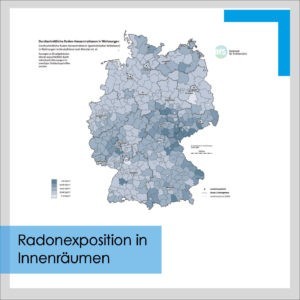In our environment, we are constantly exposed to the influence of radiation. According to the Federal Ministry for the Environment, Nature Conservation and Nuclear Safety, the average annual effective radiation dose in Germany is about 3.8 mSv. Of this, 1.7 mSv is due to civilisational sources of radiation and about 2.1 mSv is due to natural radiation exposure. Of these 2.1 mSv, 1.1 mSv are due to exposure to radon and its decay products. Radon is a natural noble gas produced by the decay of radioactive elements such as uranium and thorium. These elements occur in varying concentrations in soil, rock and spring water. Radon itself decays with a half-life of 3.825 days by emitting alpha radiation according to its radioactive decay chain into elements such as polonium (Po218) and lead (PB214). Radon is colourless, odourless and tasteless and thus not perceptible to humans. If air enriched with radon is inhaled, the risk of developing lung cancer increases. Radon is thus considered the second most common cause of lung cancer after smoking.
The harmful effect of radon was already recognised in the 16th century, although it was not yet known as an element. In Schneeberg in the Ore Mountains, an acute accumulation of severe, mostly fatal lung diseases was observed among miners, which became known as "Schneeberg mountain sickness". The high dose of alpha radiation from inhaled radon was identified as the cause.
Radon is quickly diluted outdoors and does not normally pose a problem there. As a gas, radon is highly mobile and can enrich the indoor air in basement and ground floor rooms near the geogenic source of radon, via entry routes such as cracks in the foundation or leaking cable and pipe shafts in contact with the ground.
For this reason, it makes sense to keep the radon concentration as low as possible in rooms where people are not only temporarily present. Measures against radon exposure can be taken with simple means. When renovating existing buildings, leaks in the part of the building in contact with the ground must be eliminated to prevent radon from penetrating. In addition, ventilation systems can be installed, pressure ratios regulated and even suction below the floor slab can be considered. For new buildings, it is necessary to build "radon-proof" from the beginning.
To avoid a risk for oneself and one's family, it is therefore important to determine the situation in one's own house. If increased radon exposure is detected, various measures must be taken to reduce the penetration of radon into the building. Thus, radon protection measures can be implemented with simple means to protect health.
For more information on the predicted average radon exposure in the different regions and on prevention and protection measures, see:
https://www.bfs.de/DE/themen/ion/umwelt/radon/karten/karten_node.html
https://publikationen.sachsen.de/bdb/artikel/26126
http://www.koraev.de/html/index.html
Learn more about our work and projects and follow us:
#mullandpartners #engineeringforabettertomorrow #radon 1TP5Buildingmaterials 1TP5Environment 1TP5Healthhazard



